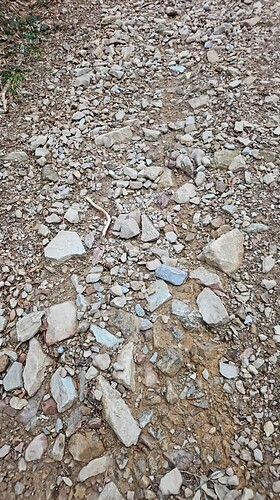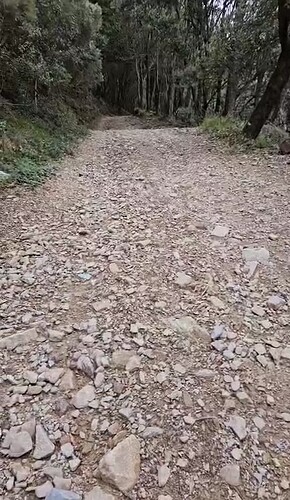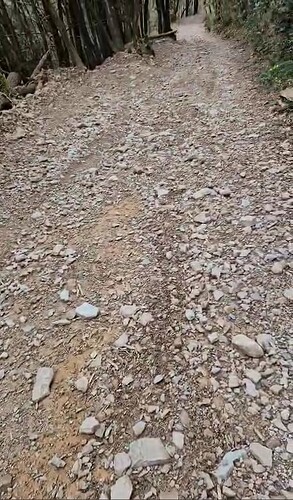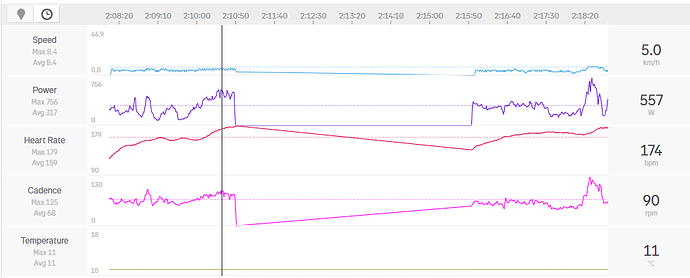Measure lactate and you will get a more complete view of your personal profile.
I did with the test I made with the mask at the sport center, but I’ve not a profile of how much carbs/fat I use at the different intensities. In any case those are only related to the HR, not the cadence. During the test I only received instructions to ride the the cadence I was finding better, and try to not change it much (I remember I made the test steadily at 88rpm)
This is a borderline case, in the sense that low HR (and being fasted or low carb far before training) should be using mostly fat, but “high” power should be using more glycogen. Since it made you tired that would be an indicator you are likely not in a fat burning state but the only way to know for sure would be this RQ test and since you were already busy that day your body is likely to see it as stress and use glycogen… So my feeling is like @MedTechCD’s in general. But this was a bad test since you had a busy day before…
In the past we had a guy here that could ride all day 85% of FTP and we looked at his HR and he was the middle of Zone 2… so 85% for him actually felt reasonably easy. So these tend to be outlier cases that are hard to know exactly what is going on. But it sounds like you are not so far off of him. Now in the cases I have seen this, it’s more like a TTer type of profile. You are an MTB rider so that tends to align with people that have fairly big anaerobic capacities but that is just a stereo type. So more sprinter or pursuiter than TTer…
There are ways to get indicators with at home tests. Read maffetone and follow his protocol and compare that to eating carbs before, your HR at least in the beginning will start about 10bpm higher than without the carbs… This is an indicator.
You could do low intensity and wear a CGM and what I have seen and others is if you are really fat burning your glucose will stay fairly flat or a very gradual decrease.
You could possibly try keytone test strips. I just got a mojo-keto blood ketone test kit I am going to try.
A test after such a busy day may skew the results in a big way. Well, compared to the protocols for 99% of the lab tests any way, which are not always representative for real life conditions…
I would say, go for a 250km race, and see what you have left at the finish line when doing your final effort.
There are multiple things that I’m questioning in your journey. Like doing long duration endurance rides on multiple back to back to days. If you’re truly below VT1 (not only HR but also Power), and have the fitness that can be expected for someone with an FTP like you, you should have no problem with doing those 3 or 4 days in a row. Maybe you can, and you’re one of those outliers, but most people will need to cut it short because the legs get to heavy and need more recovery. The thing is that true low endurance can be recovered from in less then 24 hours. You can repeat it for several days in a row without loosing performance and you can build very high volume that way. That high volume will give you a lot of room for higher intensity once you reduce volume because you will recover much faster.
I have never been a fan of any form of maximal test. I use sub-max tests all the time to keep an eye on progress. And that’s because sub-max tests minimally disturb my weekly routine. My mantra is pretty simple, don’t do anything today that might jeopardize my planned training for tomorrow. If it does, the outcome of both days together will almost always be inferior then what was planned.
It is very hard for me to imagine that you could ride for hours in a row at such low cadence and do it over again the next day. But I could just be totally wrong because that’s the beauty of the human body. There’s somewhere a bell curve, but it wouldn’t be the first time that someone far outside of the bell curve takes the win…
I agree with everything you said, (the idea of zone 2 is you can do it everyday for your typical ride length and feel fine). My gut feel is like Claude’s that your "zone 2’ is too hard and 3 hours with your kids should not affect a zone 2 ride (i.e. make it hard). Unless that was a hard 3 hours with your kids, then maybe… And I also agree if his normal cadence is 80+ and did 68 that is some kind of indicator of something going on. This is not good testing other then the fact is pointing to the idea that your Z2 is likely too hard.
Tnx for your feedbacks gents.
I agree that it wasn’t a very good test, far from optimal conditions.
The only thing I can say that also the first time it wasn’t too easy. I feel the Z2 made indoor not easy in general.
What Alex said is true about me as a mtbiker. I’ve a w’ of about 25000 kjoule and cp of about 260w. Not big numbers, but I can sustain peak efforts for quite a bit. 5 second sprints are also in the 1100 watt area, and without much training for sprints.
After vacation I’ll repeat all tests, including ftp test and see what comes out.
The breath / talk test confirms that at 135 bpm I’m in Z2. I was able to talk to wife without problems, but in any case feeling that legs were working. I think that I could have sustained that workout for two or three hours, but surely not the full day.
I also agree that sub maximal tests are less impacted by external factors that might screw up the result.
At the moment, however, it would be nice for me to find more evidences of the impact of low cadence on Z2 workouts. I’m used to ride 1000 mt of uphill at 10% slope or more at 70 rpm or less. In some cases very steep parts at 45 / 50 rpm also.
I normally do (also tomorrow) the CJ SFR workouts below 35 rpm (to stress more the muscles)
Wow, this discussion is on fire (probably carbs). I like all the side steps.
Yes, that is kind of what I’m saying, Diederik. One of the reasons that trainers prefer power over hr is that the latter is influenced by a lot other factors. A hot day will raise your heart rate extra.
So on hot days I’m riding longer is zone 5 than I could sustain on cold days, without my performance being better or worse.
Your body is not always in the same shape. If you go to a birthday in your taperweek and kiss everybody a happy birthday, you might catch something with doesn’t really make you sick, but as soon as you get on the bike you can’t perform like you would expect. Ever experienced that.
Your body might have a slight fever, you are not fully rested or recovered of you’re very stressed.
All these things can make your heart rate higher than usual . Some influence your performance too.
So, your body is not the same every day. Especially for amatures that have so many distractions.
@MedTechCD: I understand you’re point about cadence. The things you say are right, but research shows that cadence is very personal. So testing at 80 rpm used to be a standard, but not beneficial for everybody. Riders are most efficient at their personal preferred cadence.
You can/ should train cadence, but I would always recommend the personal preferred cadence.
Hi @Robert_UCL
thank you for your contribution!
Do you also have the same opinion of @MedTechCD that I was riding on carbs and not aerobically? My personal preference is always low cadence; I’m training for higher cadence, but I feel it always harder.
As soon as I start to go over 80rpm my HR goes up and I feel using more energies than riding at lower cadence. It’s my beeing, I guess ![]()
Exactly!!! Normally just ride your natural cadence but slowly over time just do cadence drills and maybe it will go up, maybe not. If it does not don’t worry about it. For sure do natural for any zone 2 stuff.
2 funny things in life : riding a bike and talking about it ![]()
@Robert_UCL : to eleborate on the topic of heartrate, it’s a facinating one. Let me add an example that happened to me a couple of times : while doing a long Z2 heartrate based indoor ride, I was watching a volleyball game of my favorite team. My average HR was 5-10 beats higher and what is even more funny : you can see the end of each set in my heartrate chart ![]()
Now having said that, if your goal is the mitochondrial adaptation of Z2, what is most accurately reflecting the “zone” in which these happen? My Z2 goes to 128 (I’m old…). So if I’m riding at 138, I’m in Z3 and my training for the goals I’m setting myself is less efficient (some would even say : not efficient). So, the wonder of HR mode in trainerday is that none of this matters, I put it at 120 and I don’t need to care.
From all the articles I’ve read, my understanding is this is how it works because while not perfect, the closest indicator to how this whole training adaptation system works is HR. Closest as in : the one we can measure continuously with a simple device.
So on a hot day, doing a Z2 ride in my understanding means you need ot lower your power. Or you’re in Z3 and that not what you want, a 3 hours ride in Z3.
Same for heat training (oh, another “hot” topic). I did this least year in prepartion for a cycling trip. In 3 weeks I got a couple of extra points in the bag on VO2max. Which was very welcome for 4 mountain rides. Anyway : the way I did these, did them indoors, with winter clothing on (yeah, heat training is a bit messy) and you absolutely can’t make up anything of both the HR as the power data. It’s so funny, Garmin Connect is totally lost, because it usually takes the temperature measure on your device into the equation. Which was now just showing the room temperature. One would need something like the overprices Core Sensor to make sense out of the data. But the point is : I was after other adaptions in these session (and they did work for me).
But back to the topic : my understand is the HR is showing what adaptions you can expect. Am I wrong ? (or even more interesting : has there ever been any study about this)
In my experience this is part of training adaptations. I started riding about 4 years ago (initially because I couldn’t do my other favorite sports anymore, after about a year because I became kind of addicted to it). So I was already 50’ish and had never done any real cycling training before. When I started my natural cadence was around 73. When I would cycle at a faster cadence, my heartrate would go up quite significantly. Fast forward : now my natural candence is around 88, even slightly above. And my HR is not impacted by cadence anymore. I’m actually enjoying a Z2 ride around 92 RPM now.
What happened ? nothing special, a lot of riding indoors (yeah, the “beautifull winters” in Belgium.
The transfer to “normal outdoor riding” is quite interesting. I did a couple of climbs in the South of France in my first summer that I was riding. I compared those to how I do these today. Yes, while the power has changed a lot (thanks God ![]() ) what has changed even more spectacular is the cadence. First year I could grind up those slopes at around 70RPM, now I’m doing 85RPM. didn’t do anything special to train is, it just came with the riding.
) what has changed even more spectacular is the cadence. First year I could grind up those slopes at around 70RPM, now I’m doing 85RPM. didn’t do anything special to train is, it just came with the riding.
On that topic 2 more observations :
when my legs are fatigued, my “natural” RPM is about 10RPM lower when I start a session. Slowly without thinking the RPM goes up, while the blood starts flowing. I saw a recent video on durabilily point out exactly this : when you do interval in the beginning of a ride and you repeat the same intervals after 3 hours of riding, the candence will be the first indicator of fatigue.
second one : during my first years on the bike, my HR was not only fluctuating with cadence, but also … with the position on the bike. The more “non aero”, as in straight up, I would sit, the lower the HR. on my indoor setup, I have a TT bar (which is very handy for long winter Z2 rides). in the aero bars, my HR would be higher. Same for riding in the drops. Since I got Trainerday, I didn’t have to worry about it anymore, it is adjusting the power itself. Again fast forward : after 4 years of riding, that thing is gone. Doesn’t matter anymore what position I’m in, the HR is stable.
Adaptations to training. The human body is a miracle ![]()
regarding HR spikes not motivate by the workout I had also another funny experience: I was riding very slowly (z1) on a flat course, preparing for a very steep 23% (avg) uphill full of stones and very bad ground (pictures below) that I was never able to ride (and it’s still one of my goals for 2025). While approaching the uphill my HR started to go up without any motivation other than the adrenaline and the fear to fail again ![]() it was very funny to see +10 bpm more while the start of uphill was arriving
it was very funny to see +10 bpm more while the start of uphill was arriving ![]()
you forgot the most important thing : did you get up without falling?
I failed again ![]()
in the second picture you see where I stopped, I missed 20-30 meters from the part where the 25% (in that part) was going to around 20% for few meters. My HR was at 182 when I stopped (almost unable to breath) and it was super hard to pedal because every 2-3 meters the back wheel was losing grip due to the stones and the front wheel was losing contact with ground (I was seated on the tip of the saddle, but still very hard to keep the wheels on ground).
Strava reports 179 bpm, but I saw 182 on my Bryton. I’ll do it, soon or later this year ![]()
I am with you on this. To me, Maffetone and possibly Dr San Milan proved the value of Z2. Robert is obviously not bought into this idea ![]() But your logic is sound with me, which is HR makes total sense, and because HR goes up, for one if you are paying attention, it forces you to relax and breath better, and two increased HR does come with some additional stress… Your body is doing something that requires a little more blood flow. It also safe guards you from potentially doing more than intended… sure some times a power target might work, especially if you set it deliberately low but HR is proven from my perspective. Both in Maffetone’s tens of thousands of followers as well as my personal experience.
But your logic is sound with me, which is HR makes total sense, and because HR goes up, for one if you are paying attention, it forces you to relax and breath better, and two increased HR does come with some additional stress… Your body is doing something that requires a little more blood flow. It also safe guards you from potentially doing more than intended… sure some times a power target might work, especially if you set it deliberately low but HR is proven from my perspective. Both in Maffetone’s tens of thousands of followers as well as my personal experience.
Maybe get an electric bike? ![]() or find a better goal for old people? Golf perhaps?
or find a better goal for old people? Golf perhaps?
AHHAHHA ![]()
no, I’ll do it this year. I also need a good day without too many stones on the ground, it’s the main limiter to ride at a steady cadence and grip.
My HR was going up mostly when scared to fall down when losing grip (on both wheels) than for the effort. And when it peaked 182 it was too much to sustain for a long time (my HR threshold is 171)
This year you’ll hear me that I did it ![]()
I already did 3 weeks ago another one like this, but with fewer stones that I was never able to ride in the past ![]()
Maybe bigger tires? Or after it rains slighly, not mud but a bit more traction? I have faith you will do it.
I’ve 2.4" tyres. The problem is not getting traction in the mud (normally it’s dry), but getting traction on stones on a 22% slope (and the hard part is around 24% or more). Bigger tyres would not help. You need to pay a lot of attention on where you put the front wheel.
I hope the success will arrive soon, fingers crossed ![]()
Yep I get it.



